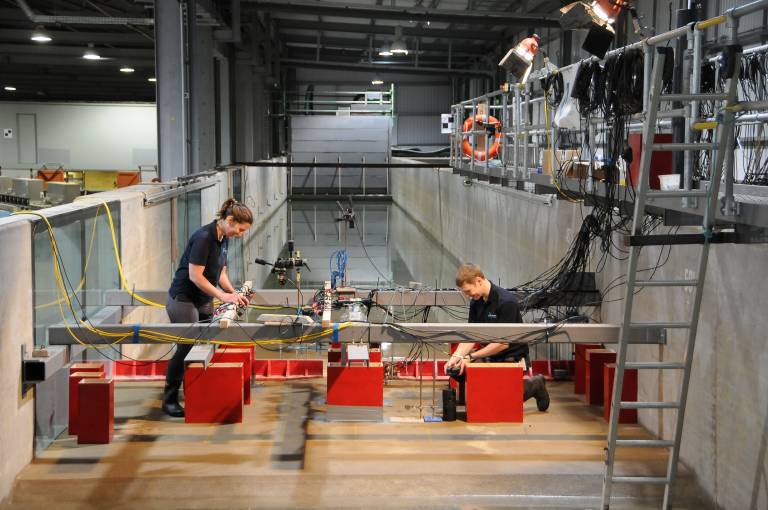CEGE and HR Wallingford tsunami generator project encourages building guidance rethink
3 December 2019
The understanding of the forces exerted by tsunami waves on sea walls and coastal buildings has leapt forward through research conducted by UCL Civil, Environmental and Geomatic Engineering (CEGE) staff, and HR Wallingford, using a third generation tsunami simulator.

Since 2014, UCL CEGE academics and researchers, led by UCL EPICentre co-Director Prof Tiziana Rossetto, have undertaken experiments with HR Wallingford’s new tsunami simulator, generating surprising and important findings. The €1.9 million project, entitled Urban Waves, has yielded results which will help update guidance for constructing and assessing buildings and sea defences in tsunami-prone areas.
The UCL team and researchers from HR Wallingford used bespoke tsunami simulators in 2015 and 2016 to conduct experiments for Urban Waves, which was funded by the European Research Council. The joint team then spent the following two years analysing the resulting data, with many important findings coming to light thanks to the cross-disciplinary approach.
To run the necessary physical experiments, HR Wallingford - an independent engineering and environmental hydraulics organisation - built two bespoke tsunami simulators. The most advanced of their kind, the simulators outperform earlier generations by providing realistic representations of tsunamis. This latest, third generation of simulator is the largest specialist tsunami device in Europe, with dimensions of 70m length and 4m channel width, and uses 70,000 litres of water to simulate a tsunami. As part of the Urban Waves project, researchers demonstrated that the test facility’s size makes it possible to simulate the full duration of a tsunami’s longer wavelengths, which act very differently to conventional storm waves.
Researchers measured how different forces are changed or magnified depending on how buildings are clustered together in coastal towns. In parallel to these experiments, they also developed new approaches for the structural analysis of buildings which are hit by tsunami flooding, and showed that buildings must rely on their strength for resisting forces imposed by tsunamis. As earthquake engineers, the UCL team also investigated what happened to buildings when a tsunami followed an earthquake, and demonstrated that earthquake damage made little difference to a building’s subsequent tsunami resistance.
One notable finding was that the amplitude of tsunami waves does not decrease as they run up the beach, as previously assumed. This is important in calculating the areas potentially flooded by a tsunami, which in turn inform evacuation plans. The research led to the team developing new experimentally-based equations for estimating tsunami forces on coastal structures.
HR Wallingford experts also supported the UCL team with running and analysing experiments which produced unique data on scour (holes formed in the ground when huge amounts of water goes past a building). Scour can result in the lifting of a building’s foundations, and the experiments found that the scour hole measured during the tsunami inundation is significantly greater than the maximum depth observed after the tsunami has ended. The implications of these findings are significant for design standards which base their scour risk on observations made of scour holes after past tsunami.
Prof Rossetto, Professor of Earthquake Engineering within CEGE, noted the “growing recognition” in the tsunami community of “the advantages posed by the Wallingford tsunami simulator, which others are trying to replicate. By raising awareness of gaps in this field, we believe our Urban Waves project has contributed to stimulating research worldwide into the impact of tsunami inundations on buildings.”
Professor William Allsop, Technical Director of Maritime Structures at HR Wallingford, who co-supervised the development of the facility and subsequent research, added: “In our initial work, we modelled the facility using advanced computational fluid dynamics tools developed at HR Wallingford, thus ensuring that this facility has the widest possible capabilities in modelling tsunamis.
“The unique feature of the latest HR Wallingford tsunami simulator is that its tank-based generator allows us to generate a realistic tsunami wave, so simulating the full duration of a tsunami wave – a 20 minute wave duration is scaled to just over two minutes in the lab. Almost no other device can do this.”
Links
Please note, some links lead to external sites.
- UCL Civil, Environmental and Geomatic Engineering
- UCL EPICentre
- Prof Rossetto CEGE profile
- HR Wallingford website
- HR Wallingford Dec 2019 article
- The science of tsunamis: Sept 2016 HR Wallingford article
- European Research Council website
Image
- Caption: Members of the Urban Waves team setting up the third generation tsunami simulator at HR Wallingford.
- Credit: HR Wallingford.
 Close
Close

